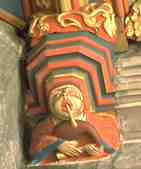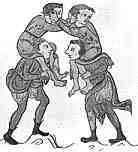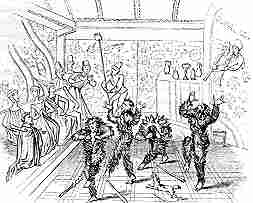 |
|
Drama
(5) |
|
By
definition, purely oral peformance leaves no written traces, but there is
evidence from written and pictorial sources that it was there. The portrayal
of musicians in many forms of medieval art indicates that musical performance
was culturally significant. |
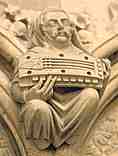 |
A
hurdygurdy player performs on a 14th century label stop in the nave of Beverley
Minster, while a bagpiper puffs out his cheeks on a 15th century corbel in
St Mary's church, also in Beverley. |
|
|
Performance
spectacles, in both public areas and in the dining halls of the gentry,
included juggling and acrobatics, wrestling, games, and animal performances
such as bear baiting, which would now be considered very incorrect. Minstrelsy
involved music, poetry and performance. Mumming or disguising involved
participants in costume invading an event and presenting a tableau or
mime. Public mumming was prohibited in many places in the 15th century,
presumably because it involved cloaking one's identity in a public place,
which could be used for those getting up to no good. No doubt it still
provided a good party trick. Froissart, in the late 14th century, describes
a particularly unfortunate case in which some members of the flower of
the French aristocracy were burnt to death by arriving at an occasion
in inflammable costumes, and some idiot came up with a torch to try and
find out who they were. |
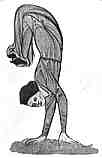 |
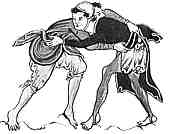 |
|
|
Images
from the initials and borders of a mid 13th century psalter in a private collection
show a tumbler, two wrestlers and a piggyback wrestling match. |
|
Aristocratic
spectacles included the tournament, in which the concepts of chivalry
embodied in the romances
were transformed into live action spectaculars. Although disapproved of
by the church, they were tolerated as means of training the defenders
of Christianity. They were affirmative of class structure. They were also
dangerous. While they were non-literate events, they certainly had elements
of theatre. |
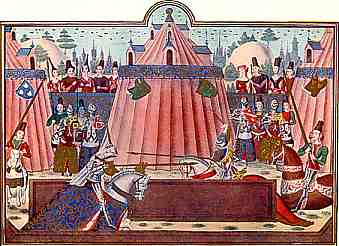 |
Illustration
of a tournament at St Inglevere, near Calais, after an illustration in a manuscript
of Froissart's chronicles in the British Library. |
|
Public
spectacles in the towns could include civic pageants which were staged on
big occasions. Public punishment was also performed in theatrical mode, whether
in the form of shaming rituals in which miscreants were forced to wear strange
clothes, or arranged in humiliating poses, while the town musicians piped
them out of the city gates, or the full public execution, with nasty things
done to bodily parts. |
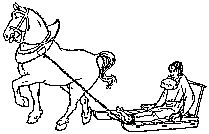 |
The
fate of a baker selling short weight loaves. |
|
The
theatrical ritual and pageantry of the town and the aristocracy may be preserved
for us to some degree through written description and reference, or even prohibition.
That of the rural areas is much harder to know clearly. Ancient agricultural
rituals of birth, death and renewal have become entangled with Christian values
and rituals. These have been suppressed, forgotten, rediscovered and reinvented
until what passes for traditional rural festivity and display is simply a
jumble of mangled fragments. People bounce around in costumes made from shredded
fabric or tie bells around their knees and hit each other with sticks, but
what it really has to do with medieval village folk display is anybody's guess. |
|
The
performance known as The Mummer's Play, which is a parody of the death
and resurrection theme involving St George, has no written texts earlier
than the 18th century. There may be concepts there from local theatrical
events of the distant past, but continuing revision and innovation has
obscured them. Perhaps the only relationships to medieval mummery are
the general concepts of parody, buffoonery and the disguising of identity. |
|
|
Court
mummers, after a manuscript in the British Library. |
 |
Puppet
shows are depicted in medieval manuscripts,
as in the example at left. It looks like a Punch and Judy show (there
is a man with a big stick), but is that merely a debasement of an earlier
form of theatre? And were these shows mainly for the entertainment of
children? Perhaps, like animal fables and fairy tales, these are a form
of entertainment that has moved from the general to the purely childish
arena. These pictures of puppet shows are found as marginalia in important
volumes of romance or psalters,
in that strange juxtaposition of rustic imagery with significant texts
that is such a feature of the 14th century. |
|
Marginal
illustration in a mid 14th century copy of the Romances
of Alexander in French verse, of all things (Bodleian Library,
MS Bodley 264, f.54). |
|
|
The
relationship between oral performance and literate drama is hard to assess,
as each may have drawn, to some degree, on the other. In England the earliest
fragment of the text of a play about Robin Hood dates to around 1475, about
the same time as such a play is referred to in one of the Paston letters.
There are suggestions that these may derive at least partly from village May
Games. However, the late 13th century French play Le
Jeu de Robin et Marion was a courtly pastoral piece which had nothing
to do with lusty Saxon yeomen leaping about the greensward in Lincoln green.
It seems that literate aristocratic culture and illiterate festivity may have
been crossing over in various directions. |
|
When
Shakespeare and his pals set up their theatres in London and brought a new
commercial aspect to staged drama, they were building on vigorous living traditions,
albeit battered by religious change. They used them too. |
 previous page
previous page |
 Categories
of Works Categories
of Works |
|
 |
 |
 |
 |
 |
 |
 |

